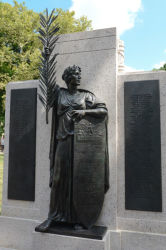Saratoga Park
Saratoga Park
What was here before?
Prior to its acquisition as a park, this site, a full square city block, was the property of James C. Brower and his wife. The open land was used as a circus grounds.
How did this site become a park?
The City of Brooklyn purchased the land for park use in 1896. The park was soon graded and planted, and workers laid new paths and enclosed the area with an iron picket fence. The land’s conversion into a park was said to be “greatly appreciated by the owners of property in the neighborhood.” A brick and wood frame shelter was erected in the park in 1903.
In 1914 the park’s gas lamps were electrified and replaced with tungsten-powered luminaires.
In the center of the park stands a bronze and pink granite memorial dedicated in 1921 to neighborhood residents who died in World War I. The Italian immigrant sculptor, James Novelli (1885-1940), designed the bronze figure representing Columbia who holds a frond of victory in her right hand and rests her left hand on a shield. Two honor rolls bear the names of 106 fallen soldiers from the neighborhood. The original plaques were stolen in 1974, and the bronze figure was stolen in 2000. In 2014 the monument was restored, and the missing honor rolls and sculpture recreated by referencing archival photos.
The playground was built on the east side of the park in 1964. A renovation completed in 2023 kept the placement around a central corridor and transverse path to maintain the existing footprint and preserve mature trees. It includes three steel play units, one dedicated to pre-school children, one ramped for accessibility and one for pre-teens. The spray shower features interactive ground sprays. New planting, seating and lighting enhanced the site while ensuring clear sightlines to the park.
What is this park named for?
The park, the second largest in the historic Bedford-Stuyvesant neighborhood, takes its name from the avenue flanking its eastern border. The street itself was named in 1835 for the upstate town of Saratoga, the scene of an important Revolutionary War battle. Saratoga Avenue is one of a series of streets in the community named for New York state towns and cities. The name is thought to be a Dutch adaptation of Iroquois or Mohawk tribal origin, and has been ascribed multiple meaning attributions such as “vale of springs”, “place of miraculous water in rock,” or “beaver place.”
Check out your park's Vital Signs
Clean & Safe
Green & Resilient
Empowered & Engaged Users
Share your feedback or learn more about how this park is part of a
Vital Park System






